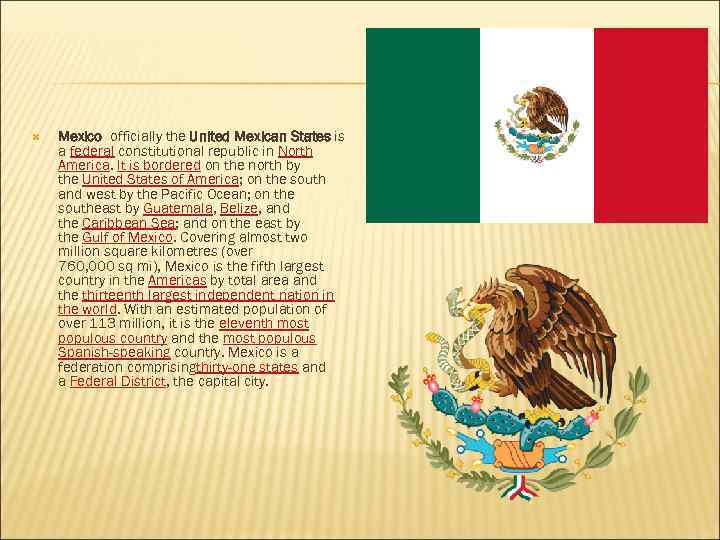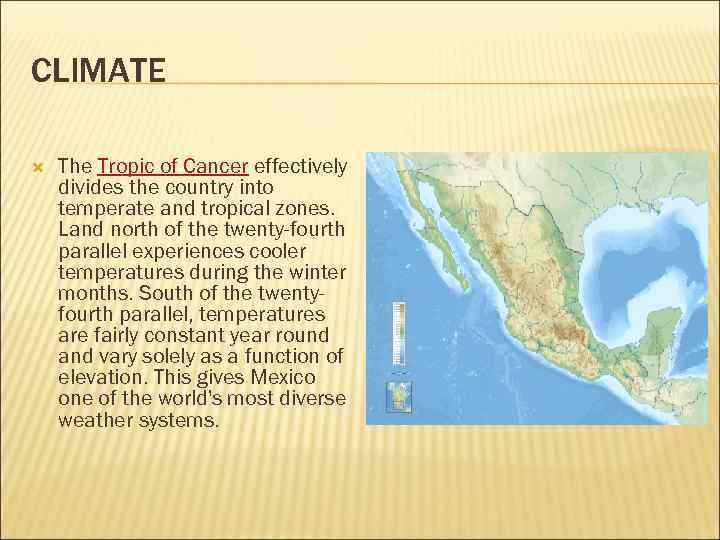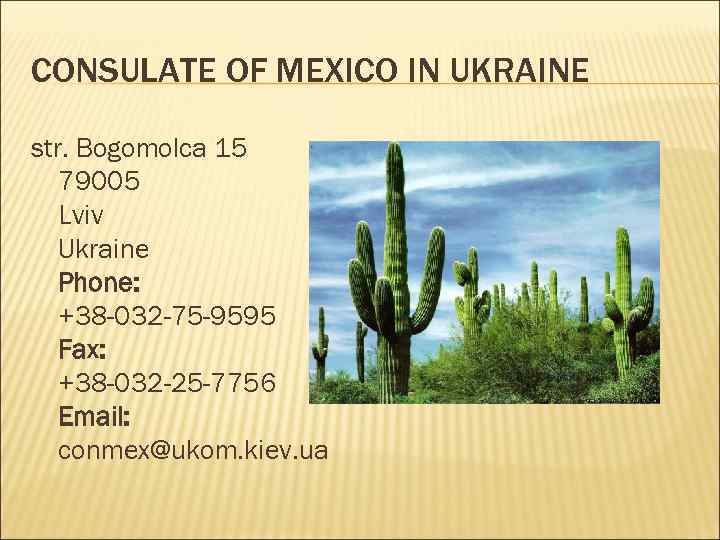 Karina Ivanova MEXICO
Karina Ivanova MEXICO
 Mexico officially the United Mexican States is a federal constitutional republic in North America. It is bordered on the north by the United States of America; on the south and west by the Pacific Ocean; on the southeast by Guatemala, Belize, and the Caribbean Sea; and on the east by the Gulf of Mexico. Covering almost two million square kilometres (over 760, 000 sq mi), Mexico is the fifth largest country in the Americas by total area and the thirteenth largest independent nation in the world. With an estimated population of over 113 million, it is the eleventh most populous country and the most populous Spanish-speaking country. Mexico is a federation comprisingthirty-one states and a Federal District, the capital city.
Mexico officially the United Mexican States is a federal constitutional republic in North America. It is bordered on the north by the United States of America; on the south and west by the Pacific Ocean; on the southeast by Guatemala, Belize, and the Caribbean Sea; and on the east by the Gulf of Mexico. Covering almost two million square kilometres (over 760, 000 sq mi), Mexico is the fifth largest country in the Americas by total area and the thirteenth largest independent nation in the world. With an estimated population of over 113 million, it is the eleventh most populous country and the most populous Spanish-speaking country. Mexico is a federation comprisingthirty-one states and a Federal District, the capital city.
 HISTORY The earliest human remains in Mexico are chips of stone tools found near campfire remains in the Valley of Mexico and radiocarbondated to c. 23, 000 years ago. Mexico is the site of the domestication of maize and beans which caused a transition from paleo. Indian hunter-gatherers to sedentary agricultural villages beginning around 7000 BCE.
HISTORY The earliest human remains in Mexico are chips of stone tools found near campfire remains in the Valley of Mexico and radiocarbondated to c. 23, 000 years ago. Mexico is the site of the domestication of maize and beans which caused a transition from paleo. Indian hunter-gatherers to sedentary agricultural villages beginning around 7000 BCE.
 ADMINISTRATIVE DIVISIONS The United Mexican States are a federation of thirty-one free and sovereign states, which form a union that exercises a degree of jurisdiction over the Federal District and other territories. Each state has its own constitution, congress, and a judiciary, and its citizens elect by direct voting a governor for a sixyear term, and representatives to their respective unicameral state congresses for three-year terms. The Federal District is a special political division that belongs to the federation as a whole and not to a particular state, and as such, has more limited local rule than the nation's states.
ADMINISTRATIVE DIVISIONS The United Mexican States are a federation of thirty-one free and sovereign states, which form a union that exercises a degree of jurisdiction over the Federal District and other territories. Each state has its own constitution, congress, and a judiciary, and its citizens elect by direct voting a governor for a sixyear term, and representatives to their respective unicameral state congresses for three-year terms. The Federal District is a special political division that belongs to the federation as a whole and not to a particular state, and as such, has more limited local rule than the nation's states.
 POLITICS The National Palace, symbolic seat of the President and the cabinet. President Felipe Calderón The United Mexican States are a federation whose government is representative, democratic and republican based on a presidential system according to the 1917 Constitution. The constitution establishes three levels of government: the federal Union, the state governments and the municipal governments. According to the constitution, all constituent states of the federation must have a republican form of government composed of three branches: the executive, represented by a governor and an appointed cabinet, the legislative branch constituted by a unicameral congress and the judiciary, which will include called state Supreme Court of Justice. They also have their own civil and judicial codes.
POLITICS The National Palace, symbolic seat of the President and the cabinet. President Felipe Calderón The United Mexican States are a federation whose government is representative, democratic and republican based on a presidential system according to the 1917 Constitution. The constitution establishes three levels of government: the federal Union, the state governments and the municipal governments. According to the constitution, all constituent states of the federation must have a republican form of government composed of three branches: the executive, represented by a governor and an appointed cabinet, the legislative branch constituted by a unicameral congress and the judiciary, which will include called state Supreme Court of Justice. They also have their own civil and judicial codes.
 GEOGRAPHY Mexico as seen from space in a satellite photo taken by NASA's Suomi NPP in January 2012. Mexico is located between latitudes 14° and 33°N, and longitudes 86° and 119°W in the southern portion of North America. Almost all of Mexico lies in the North American Plate, with small parts of the Baja California peninsula on the Pacific and Cocos Plates. Geophysically, some geographers include the territory east of the Isthmus of Tehuantepec (around 12% of the total) within Central America. Geopolitically, however, Mexico is entirely considered part of North America, along with Canada and the United States.
GEOGRAPHY Mexico as seen from space in a satellite photo taken by NASA's Suomi NPP in January 2012. Mexico is located between latitudes 14° and 33°N, and longitudes 86° and 119°W in the southern portion of North America. Almost all of Mexico lies in the North American Plate, with small parts of the Baja California peninsula on the Pacific and Cocos Plates. Geophysically, some geographers include the territory east of the Isthmus of Tehuantepec (around 12% of the total) within Central America. Geopolitically, however, Mexico is entirely considered part of North America, along with Canada and the United States.
 CLIMATE The Tropic of Cancer effectively divides the country into temperate and tropical zones. Land north of the twenty-fourth parallel experiences cooler temperatures during the winter months. South of the twentyfourth parallel, temperatures are fairly constant year round and vary solely as a function of elevation. This gives Mexico one of the world's most diverse weather systems.
CLIMATE The Tropic of Cancer effectively divides the country into temperate and tropical zones. Land north of the twenty-fourth parallel experiences cooler temperatures during the winter months. South of the twentyfourth parallel, temperatures are fairly constant year round and vary solely as a function of elevation. This gives Mexico one of the world's most diverse weather systems.
 BIODIVERSITY Mexico is one of the 18 megadiverse countries of the world. With over 200, 000 different species, Mexico is home of 10– 12% of the world's biodiversity. Mexico ranks first in biodiversity in reptiles with 707 known species, second in mammals with 438 species, fourth in amphibians with 290 species, and fourth in flora, with 26, 000 different species. Mexico is also considered the second country in the world in ecosystems and fourth in overall species. Approximately 2, 500 species are protected by Mexican legislations.
BIODIVERSITY Mexico is one of the 18 megadiverse countries of the world. With over 200, 000 different species, Mexico is home of 10– 12% of the world's biodiversity. Mexico ranks first in biodiversity in reptiles with 707 known species, second in mammals with 438 species, fourth in amphibians with 290 species, and fourth in flora, with 26, 000 different species. Mexico is also considered the second country in the world in ecosystems and fourth in overall species. Approximately 2, 500 species are protected by Mexican legislations.
 ECONOMY A zona marginal in the State of Mexico. 46% of the Mexican population lives in moderate to extreme poverty according to national statistics. Mexico has the 13 th largest nominal GDP and the 11 th largest by purchasing power parity. GDP annual average growth for the period of 1995– 2002 was 5. 1%. Foreign debt decreased to less than 20% of GDP. 17% of the population lives below Mexico's own poverty line, ranking behind Kazakhstan, Bulgaria and Thailand. The overall poverty rate however is 44. 2%, while a full 70% lack one of the 8 economic indicators used to define poverty by the Mexican government.
ECONOMY A zona marginal in the State of Mexico. 46% of the Mexican population lives in moderate to extreme poverty according to national statistics. Mexico has the 13 th largest nominal GDP and the 11 th largest by purchasing power parity. GDP annual average growth for the period of 1995– 2002 was 5. 1%. Foreign debt decreased to less than 20% of GDP. 17% of the population lives below Mexico's own poverty line, ranking behind Kazakhstan, Bulgaria and Thailand. The overall poverty rate however is 44. 2%, while a full 70% lack one of the 8 economic indicators used to define poverty by the Mexican government.
 TOURISM Mexico reports the twenty-third highest tourism-based income in the world, and the highest in Latin America. The vast majority of tourists come to Mexico from the United States and Canada followed by Europe and Asia. A smaller number also come from other Latin American countries. In the 2008 Travel and Tourism Competitiveness Index, fifth among Latin American countries, and the ninth in the Americas.
TOURISM Mexico reports the twenty-third highest tourism-based income in the world, and the highest in Latin America. The vast majority of tourists come to Mexico from the United States and Canada followed by Europe and Asia. A smaller number also come from other Latin American countries. In the 2008 Travel and Tourism Competitiveness Index, fifth among Latin American countries, and the ninth in the Americas.
 TRANSPORTATION Much of Mexico's automotive traffic depends on the national highway system. Passport stamp upon arrival in. Tijuana, Baja California land border crossing. The paved-roadway network extended for 116, 802 km (72, 577 mi) in 2005; 10, 474 km (6, 508 mi) were multilane freeways or expressways, most of which were tollways. Nonetheless, it still cannot meet national needs adequately. Most of the domestic passenger transport needs are served by an extensive bus network. Mexico was one of the first Latin American countries to promote railway development, and the network covers 30, 952 km (19, 233 mi).
TRANSPORTATION Much of Mexico's automotive traffic depends on the national highway system. Passport stamp upon arrival in. Tijuana, Baja California land border crossing. The paved-roadway network extended for 116, 802 km (72, 577 mi) in 2005; 10, 474 km (6, 508 mi) were multilane freeways or expressways, most of which were tollways. Nonetheless, it still cannot meet national needs adequately. Most of the domestic passenger transport needs are served by an extensive bus network. Mexico was one of the first Latin American countries to promote railway development, and the network covers 30, 952 km (19, 233 mi).
 POPULATION A study by the National Institute of Genomic Medicine, Mexico reported that Mestizo Mexicans are 58. 96% European, 35. 05% "Asian" (Amerindian), and 5. 03% African. Sonora shows the highest European contribution (70. 63%) and Guerrero the lowest (51. 98%) where we also observe the highest Asian contribution (37. 17%). African contribution ranges from 2. 8% in Sonora to 11. 13% in Veracruz. 80% of the Mexican population was classed as mestizo (defined as "being racially mixed in some degree").
POPULATION A study by the National Institute of Genomic Medicine, Mexico reported that Mestizo Mexicans are 58. 96% European, 35. 05% "Asian" (Amerindian), and 5. 03% African. Sonora shows the highest European contribution (70. 63%) and Guerrero the lowest (51. 98%) where we also observe the highest Asian contribution (37. 17%). African contribution ranges from 2. 8% in Sonora to 11. 13% in Veracruz. 80% of the Mexican population was classed as mestizo (defined as "being racially mixed in some degree").
 RELIGION Roman Catholicism 82. 7% Other Christian 9. 7% Other Religion 0. 2% No religion 4. 7% Unspecified 2. 7% The 2010 census by the Instituto Nacional de Estadística y Geografía gave Roman Catholicism as the main religion, with 82. 7% of the population, while 9. 7% (10, 924, 103) belong to other Christian denominations, including Evangelicals (5. 2%); Pentecostals ( 1. 6%); other Protestant or Reformed (0. 7%); Jehovah's Witnesses (1. 4%); Seventhday Adventists (0. 6%); and members of The Church of Jesus Christ of Latter-day Saints (0. 3%). 172, 891 (or less than 0. 2% of the total) belonged to other, non-Christian religions; 4. 7% declared having no religion; 2. 7% were unspecified.
RELIGION Roman Catholicism 82. 7% Other Christian 9. 7% Other Religion 0. 2% No religion 4. 7% Unspecified 2. 7% The 2010 census by the Instituto Nacional de Estadística y Geografía gave Roman Catholicism as the main religion, with 82. 7% of the population, while 9. 7% (10, 924, 103) belong to other Christian denominations, including Evangelicals (5. 2%); Pentecostals ( 1. 6%); other Protestant or Reformed (0. 7%); Jehovah's Witnesses (1. 4%); Seventhday Adventists (0. 6%); and members of The Church of Jesus Christ of Latter-day Saints (0. 3%). 172, 891 (or less than 0. 2% of the total) belonged to other, non-Christian religions; 4. 7% declared having no religion; 2. 7% were unspecified.
 CULTURE Mexican culture reflects the complexity of the country's history through the blending of indigenous cultures and the culture of Spain, imparted during Spain's 300 -year colonization of Mexico. Exogenous cultural elements mainly from the United States have been incorporated into Mexican culture
CULTURE Mexican culture reflects the complexity of the country's history through the blending of indigenous cultures and the culture of Spain, imparted during Spain's 300 -year colonization of Mexico. Exogenous cultural elements mainly from the United States have been incorporated into Mexican culture
 CUISINE Mexican cuisine is known for its intense and varied flavors, colorful decoration, and variety of spices. Most of today's Mexican food is based on pre-Columbian traditions, including the Aztecs and Maya, combined with culinary trends introduced by Spanish colonists.
CUISINE Mexican cuisine is known for its intense and varied flavors, colorful decoration, and variety of spices. Most of today's Mexican food is based on pre-Columbian traditions, including the Aztecs and Maya, combined with culinary trends introduced by Spanish colonists.
 WHAT TO SEE IN MEXICO Mexico City Beaches Colonial Cities Ancient Sites Natural Wonders Adventure tourism Mexican Food Handicrafts People, Culture and Fiestas
WHAT TO SEE IN MEXICO Mexico City Beaches Colonial Cities Ancient Sites Natural Wonders Adventure tourism Mexican Food Handicrafts People, Culture and Fiestas
 CONSULATE OF MEXICO IN UKRAINE str. Bogomolca 15 79005 Lviv Ukraine Phone: +38 -032 -75 -9595 Fax: +38 -032 -25 -7756 Email: conmex@ukom. kiev. ua
CONSULATE OF MEXICO IN UKRAINE str. Bogomolca 15 79005 Lviv Ukraine Phone: +38 -032 -75 -9595 Fax: +38 -032 -25 -7756 Email: conmex@ukom. kiev. ua


